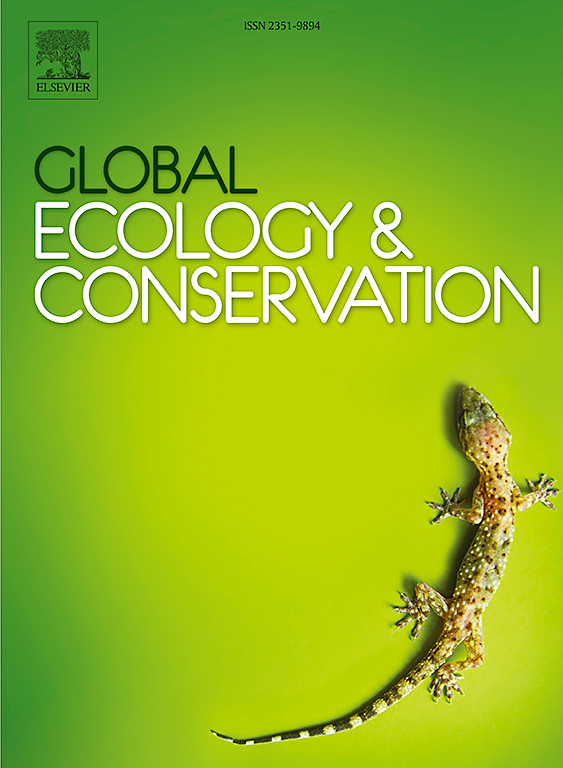非洲热带森林恢复梯度食果蝴蝶群落个体尺度分布格局
IF 3.4
2区 环境科学与生态学
Q1 BIODIVERSITY CONSERVATION
引用次数: 0
摘要
热带雨林的丧失和退化对全球保护构成了重大挑战,但森林恢复对动物群落功能多样性的影响,特别是在种内水平上的影响,仍然知之甚少。本研究调查了乌干达基巴莱国家公园沿热带森林恢复年龄梯度的果食性蝴蝶的大小分布。研究地点分为三个森林年龄组:年轻恢复(10-16年),老恢复(21-26年)和原始林。在48个地点采集了蝴蝶样本,测量了个体前翼长度,以分析平均前翼长度、多样性、偏度和峰度的变化。平均前翼长和多样性随林龄的增加而增加,偏度和峰度随林龄的增加而减小。不同年龄的森林在大小指标上存在显著差异,与较老的恢复森林和原始森林相比,较年轻的恢复森林表现出较低的多样性。在研究的12个物种中,有6个物种的前翼长度存在种内差异,与物种水平的分析相比,突出了个体水平数据提供的微妙见解。核密度分布图显示,随着森林的成熟,形态多样性逐渐向更均匀的大小分布转变。这些发现强调了考虑种内变异对理解群落对森林恢复的反应的价值。该研究强调了热带森林向原始森林发展的长期而稳定的进展,对热带森林保护和应用生态学具有重要意义。本文章由计算机程序翻译,如有差异,请以英文原文为准。
Individual-level size distribution patterns in fruit-feeding butterfly communities along a forest restoration gradient in the Afrotropics
The loss and degradation of tropical rainforests pose significant challenges to global conservation, yet the impact of forest restoration on the functional diversity of animal communities, particularly at the intraspecific level, remains poorly understood. This study investigates the size distribution of fruit-feeding butterflies along a gradient of tropical forest restoration ages in Kibale National Park, Uganda. Study sites were categorised into three forest age groups: younger restored (10–16 years), older restored (21–26 years), and primary forests. Butterflies were sampled across 48 sites, and individual forewing lengths were measured to analyse changes in mean forewing length, diversity, skewness, and kurtosis. The mean forewing length and diversity increased, while skewness and kurtosis decreased, towards primary forest age group. Significant differences in size metrics were observed among forest age groups, with younger restored forests showing lower diversity compared to older restored and primary forests. Intraspecific differences in forewing length were detected in six of the 12 species studied, highlighting the nuanced insights provided by individual-level data compared to species-level analyses. Kernel density plots demonstrated a gradual shift towards more uniform size distributions along the restoration gradient, suggesting that morphological diversity increases as forests mature. These findings underscore the value of considering intraspecific variation in understanding community responses to forest restoration. The study highlights the prolonged but steady progress towards primary forest, offering important implications for tropical forest conservation and applied ecology.
求助全文
通过发布文献求助,成功后即可免费获取论文全文。
去求助
来源期刊

Global Ecology and Conservation
Agricultural and Biological Sciences-Ecology, Evolution, Behavior and Systematics
CiteScore
8.10
自引率
5.00%
发文量
346
审稿时长
83 days
期刊介绍:
Global Ecology and Conservation is a peer-reviewed, open-access journal covering all sub-disciplines of ecological and conservation science: from theory to practice, from molecules to ecosystems, from regional to global. The fields covered include: organismal, population, community, and ecosystem ecology; physiological, evolutionary, and behavioral ecology; and conservation science.
 求助内容:
求助内容: 应助结果提醒方式:
应助结果提醒方式:


